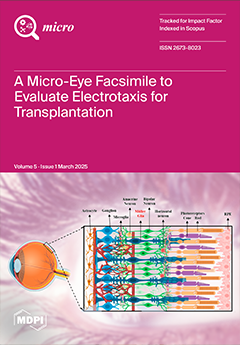Due to their biocompatibility, nontoxicity, and surface conjugation properties, nanomaterials are effective nanocarriers capable of encapsulating chemotherapeutic drugs and facilitating targeted delivery across the blood–brain barrier (BBB). Although research on nanoparticles for brain cancer treatment is still in its early stages, these systems
[...] Read more.
Due to their biocompatibility, nontoxicity, and surface conjugation properties, nanomaterials are effective nanocarriers capable of encapsulating chemotherapeutic drugs and facilitating targeted delivery across the blood–brain barrier (BBB). Although research on nanoparticles for brain cancer treatment is still in its early stages, these systems hold great potential to revolutionize drug delivery. Glioblastoma multiforme (GBM) is one of the most common and lethal brain tumors, and its heterogeneous and aggressive nature complicates current treatments, which primarily rely on surgery. One of the significant obstacles to effective treatment is the poor penetration of drugs across the BBB. Moreover, GBM is often referred to as a “cold” tumor, characterized by an immunosuppressive tumor microenvironment (TME) and minimal immune cell infiltration, which limits the effectiveness of immunotherapies. Therefore, developing novel, more effective treatments is critical to improving the survival rate of GBM patients. Current strategies for enhancing treatment outcomes focus on the controlled, targeted delivery of chemotherapeutic agents to GBM cells across the BBB using nanoparticles. These therapies must be designed to engage specialized transport systems, allowing for efficient BBB penetration, improved therapeutic efficacy, and reduced systemic toxicity and drug degradation. Lipid and inorganic nanoparticles can enhance brain delivery while minimizing side effects. These formulations may include epitopes—small antigen fragments that bind directly to free antibodies, B cell receptors, or T cell receptors—that interact with transport systems and enable BBB crossing, thereby boosting therapeutic efficacy. Lipid-based nanoparticles (LNPs), such as liposomes, niosomes, solid lipid nanoparticles (SLNs), and nanostructured lipid carriers (NLCs), are among the most promising delivery systems due to their unique properties, including their size, surface modification capabilities, and proven biosafety. Additionally, inorganic nanoparticles such as gold nanoparticles, mesoporous silica, superparamagnetic iron oxide nanoparticles, and dendrimers offer promising alternatives. Inorganic nanoparticles (INPs) can be easily engineered, and their surfaces can be modified with various elements or biological ligands to enhance BBB penetration, targeted delivery, and biocompatibility. Strategies such as surface engineering and functionalization have been employed to ensure biocompatibility and reduce cytotoxicity, making these nanoparticles safer for clinical applications. The use of INPs in GBM treatment has shown promise in improving the efficacy of traditional therapies like chemotherapy, radiotherapy, and gene therapy, as well as advancing newer treatment strategies, including immunotherapy, photothermal and photodynamic therapies, and magnetic hyperthermia. This article reviews the latest research on lipid and inorganic nanoparticles in treating GBM, focusing on active and passive targeting approaches.
Full article





